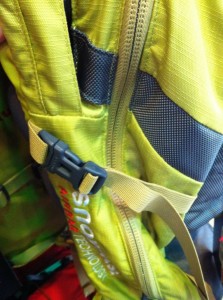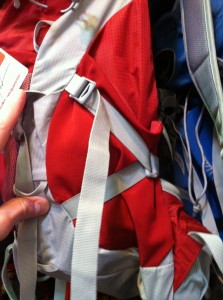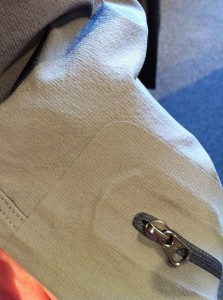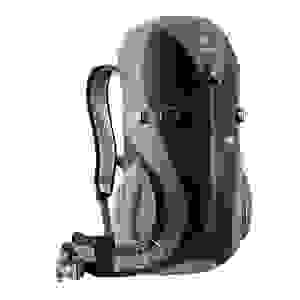Whenever it comes time to set off on another international adventure, I tweak the gear setup to as high a level of perfection as possible. It’s important to have gear that works well, stands up to abuse, and won’t let you down. With the arguable exception of quality footwear, a good backpack is the most important piece of gear you’ll bring with you, and with that being the case, there’s no reason to cut corners.

Sadly, I have yet to find my backpack soul mate. Every new trip brings the same rush of excitement, the same potential of finding The One, yet she remains just beyond my grasp.
Despite how desperately I want to find a backpack I can get to know better and with whom I can share my adventures, I buy a new one every time I go. My heart remains broken, but my spirit remains strong.
What I look for in a woman travel backpack
I don’t think it’s too demanding a list. All I want is a super amazing travel pack that is obscenely lightweight, versatile, durable, dependable, organizable, and everything else you ever hoped she it could be. Prerequisites include:
- Maximum of 40 (or so) liters: Carry-on size means I can skip the baggage claim.
- Under 3 pounds: They do exist. They’re rare, but they’re out there.
- Lots of pockets: Big ones, too. Organization is key.
- Breathable back panel: The trampoline-style mesh is great.
- Combo top loader and panel loader: Top loaders are easy to pack efficiently, and panel loaders open up like a suitcase for easy access.
- Big side pockets: Is there even a point to side pockets that can’t hold a water bottle?
- Streamlined design: As few extraneous straps as possible. These drive me insane.

Sounds simple, doesn’t it? Seems to me like most backpacks on the market should meet most of those qualifications, but, for some reason, people seem to screw things up all the time. I can’t tell you how many times I’ve tried to put a water bottle into those pitiful excuses for side pockets, only to have the water bottle fall right out again.
Even more annoying is when those extraneous straps actually cover the side pocket. Isn’t there a law against this or something?
But it’s not just the simple stuff listed above that I woud adore. Nay. I have higher standards. Technological standards. I want more. Features like…
Dream Feature #1: Welded Seams
Quick, name the first thing on a pack that fails. Did you say seams? Good job!
There’s a reason they fail so frequently. Because thread is a dumb way to hold two things together. Do we use thread to tie your couch together? No!
You can strengthen seams by sewing tough nylon strips over them, which protect the fragile thread from abrasion. This is a great idea, obviously, but it also adds weight.

But there’s a better way. A method that produces seams that are not only stronger, but lighter. You take the two pieces of fabric, stick them next to each other, and shoot them with a laser gun, then add some tape on the back for good measure. Depending on the pack design, this method can reduce weight up to 30%. Chances are you’ve got a 3 pound pack. Imagine cutting out a whole pound from that setup.
Oh, and the seams are waterproof. Neat, huh? Actually, no. It’s more than neat. Because if the seams are waterproof, you can just take the next step and employ…
Dream Feature #2: Waterproof Fabric
Got a rain cover on your pack? Lame. That’s like having a rain cover for your car. Shouldn’t it just be waterproof to begin with? Yes, it should. And if you combine welded seams with waterproof fabric, you’d have a waterproof backpack. And since the waterproof part is on the inside, the exterior is still ultra-durable nylon.
It would make zippered compartments potentially vulnerable, but all you have to do is position them properly (most likely behind a downward-pointing strip of fabric, a strategy in common use today) and you’d have no problem. Most packs are top-loaders anyway, meaning they’d be just fine.
Added bonus? You don’t have to deal with a rain cover. Not only does this help with the pointless hassle of having to attach and detach a rain cover, but you also save a few extra ounces by not needing one in the first place.
Does such a pack exist?
Well, sort of. I’ve seen a few. In fact, I owned one. It was a lightweight, ventilated, waterproof, seam-welded, svelte thing of beauty. The Deuter DS 20.

It was the pack I took on my 9 month trip, and whose 20 liter capacity serves as the inspiration for the (original) title of this site, 20 Liter Adventure, and let me tell you, seamless, waterproof construction is absolutely spectacular. It’s also incredibly easy.
So, would I recommend the pack? Well, probably not. It wasn’t particularly comfortable. It felt like it was falling backwards off my shoulders. It also didn’t have much in the way of organizational options. Just the main compartment, the top pocket (whose zipper was way too small), and two side pockets, which just barely fit a water bottle. 20 liters is also terrifyingly small for all but the lightest of ultralight backpackers. Deuter made a larger version called the DS 30 (with a totally different back panel, which I expect would be far more comfortable) but neither of these packs exist anymore anyway.
So, why bother with a eulogy for a dead pack? Because in many ways it was superior. Vastly so. And only by complaining incessantly about its achievements will its life and death have meaning. The world needs its genius. And thus its life must be celebrated.

I haven’t a clue why welded seams and waterproof construction weren’t adopted to the exclusion of all other construction techniques. They reduce weight. They increase strength. They’re simpler. They’re waterproof. They’re glorious. And this glory must be shared with the world.
Even Deuter, who built this pack, uses sewn seams, ordinary fabrics, and extraneous rain covers, seemingly exclusively. It’s like watching an Italian eating at Domino’s. It makes me cry.
I have a theory, though. Take a look at any pack and imagine the time and energy that goes into it, from design, to cutting, sewing, quality control, and shipping. These things may only cost $100, but they’re incredibly labor intensive. But a rain cover can cost as much as $40, even though it’s just a giant garbage bag with an elastic band around the edge. They can’t possibly make much money per pack, but if they talk you into buying a rain cover, they’re probably making decent money. But then again, Deuter packs often come with a free rain cover, so this can’t be the issue with them specifically.
I dream of a day when I can buy this type of pack again. A seam-welded, waterproof, ultralight, super durable, plain and simple best friend I’d happily take to every corner of the Earth and beyond.
If it were a girl, I would marry her. And I’d never look at another pack that way ever again.
Someday, my love. Someday, I’ll find you.




One pack to check out that I love is the ArcTerx Needle 45. Yes, it is a 45 litre, but it is waterproof, pretty hard to break into for those concerned with security while walking and is super comfortable. It can be a bit hard to find, but it is the pack I am taking with my for my RTW trip and I have used it for many long hikes so I know it is comfortable. It is definitely more technical climbing oriented, but I still love the pack for just about everything.
Just a thought, and here is a quick link to a review. http://www.moontrail.com/arcteryx-needle-45.php.
You might really like the Lowe Alpine Yocton 35 Backpack (they offer a 25L also). I have been on a similar quest, and this piece is a favorite of mine.
Sigh, I need a new pack for my next trip and finding one seems impossible. Will have to lower my expectations! Loved the post though.
In 1991 I borrowed a travel back pack from a friend for a trip through Mexico, Belize and Guatemala. The pack was great, and I promised myself to buy one as soon as I had a chance, but I have never been able to find one. I believe the brand was Jansport, it had an expandable bottom to it, two divided compartments (top and bottom), a detachable day pack and a lumbar (fanny) pack that also zipped right into the side of the pack. The frame was internal, and the back straps could be tucked into the zipped up back. The fit was perfect, I did a lot of hiking and traveling during 2 weeks, and it was comfortable, convenient, etc.. DO YOU HAVE ANY IDEA WHERE I COULD FIND SOMETHING LIKE THIS?
Sincerely, Ike
Anything from 1991 is probably gone…there are lots of bags with detachable daypacks (Osprey, REI, Eagle Creek and Deuter make some), but of course you’ll have to try them all out to see which one feels good.
I’m curious about your impressions of Mission Workshop backpacks for hydration (Hauser) and travel (Vandal). Have you seen or tried them? Both are waterproof and seem to tick many of the boxes for what you want in a backpack, except that the straps on the Vandal don’t stow away at all, so that may be a downside when you have to check the bag.
I’ve heard good things about them, though I haven’t tried them out in person. The weatherproof protection is great, though a top-loading, roll-top bag isn’t quite as easy to deal with as a fully-opening panel loader. You could easily supplement it with packing cubes, which would make it easier to manage, but I think this sort of rainproof, flap-top design works better with smaller daypacks, so you’re not rummaging around for something down near the very bottom. Mission Workshop has some good high-tech clothing options, too, without the techy/outdoorsy look of other companies that use the same fabrics.
I wrote this article a while back, and I’ve seen a few newly-crafted designs emerge later, so this rant is now a bit more of a throwback to a darker chapter.
The Vandal isn’t exclusively a rolltop. The main compartment is a partial zip, maybe 80% of what you’d see in a full zip. You should check one out. Also, I’d be interested in the newly crafted designs you like, both for hydration and travel packs.
Ah, I’m seeing it now on some of the product review pages from other sites. Seems like it would work. I list some of my favorite travel packs here, some of which were only recently developed. I’m not too familiar with hydration packs, but I do enjoy smaller, stuffable packs like these, some of which have hydration compatibility. I’ve really only used water bottles. I’ve thought of going with a hydration reservoir, but I’ve already got bottles anyway. They work nicely, though.
Have you looked at ZPACKS?!?!
Customized / lightweight / water proof!
http://www.zpacks.com/backpacks/arc_blast.shtml
I wouldn’t use cuban for a travel pack. Great for UL shelters and backpacking (hiking) packs, but not for carryon luggage. Abrasions from throwing it up over seats (or hiking offtrail) can tear it easily, and when you’re shelling out that much for a pack, I want it to last. Yes, cuban is the lightest, but you have to know what you’re doing and baby it.
If you can accept the downsides, I’d recommend this one instead (http://www.zpacks.com/backpacks/arc_zip.shtml) – it’s a panel loader, and that’s really what you want for a travel bag. I used to have a Six Moons Designs Traveler panel loader, but still like my Tortuga much more as it’s actually designed for travel, not hiking.
Hi, my beloved one these years is the
columbia vixen 22 liter
it is the women’s version of Columbia’s Treadlite but I dont care as a men since its slightly smaller and lighter then this. If you look up all the details you will find its avoids a lot of the traps you mentiond, the dangling straps can be fixed in lastic loops, it is halfway to open on front, it has big mesh sidepockets to hold plastic bottles or stuff and also hip belt pockets on both sides that I use also for stuffing the hip belt on short walks when not needed. Very comforable all in all. Waterproof without extra cover but nice soft material
see also
http://gumptiongear.blogspot.de/2011/10/first-look-columbias-spring-2012.html
Snarky’s article was written in April 2013, and I think it’s a little dated. A couple of things I’ve noticed these days (as at June 2015)
His weight limit is 3 pounds. I don’t think it’s difficult to find a pack which weighs 1.5kg or less at 30-40L capacity. Some of these packable/foldable packpacks you can by online from China seem well made, of 35L, and although they are stitched, the material is often water resistant/proof. If you don’t like those, then there are many “proper” packs under 3 pounds. My karrimor Trim 35L is just 800 grams, for example.
And as I mentioned, although they are stitched, many newer packs have a rubber/plastic lining inside to help weather resitant-ise the pack. They are still pricey though.
Are welded seams stronger? I read an article on Berghaus’s 2013/2014 hyper series of light equipment, and they made this 71 gram windbreaker (turn it inside out for it to be warmer/cooler- quite high tech!), and they tried welded seams but the joints tore so they went back to stitched materials. Hyper Smock, I think. They also had a Berghaus Hyper 37 L pack which weighed just 500 grams. Of course, it’s not cheap.
Yes, it’s definitely dated. I wrote this back when these were the sorts of things I was looking for. On the downside, some of these features, like waterproof construction, kind of require zipper placements at specific angles, and so on. This determines how you’ll access the pack, which may or may not be ideal, whereas a cheap rain cover will handle everything quite easily. The weight limit was mainly just a guideline, and plenty of them are under 3 lbs, but one of the most popular backpack manufacturers around here is Deuter, and they often seem to be above 3 or even 4, for no particular reason that I can see. I’ve been much happier to see the designs of these travel backpacks rather than what’s described here.
https://www.hanchor.com/products/Travel%20Series/Breccia_Travel_Backpack?locale=en
This! This is so close! Only thing it’s missing is trampoline mesh, and 3 pounds is on the heavy side but forgivable because they hit everything else. Pricey, but I might splurge once they’re available again. Might be the one to finally beat my Tortuga, which is my personal favorite at the moment.
Yeah, I saw that one a while back and I think it’s pretty cool. I like the modularity and removable inserts and things like that.
Regarding the comment above as to the fragility of Cuben material if used for backpacks, that is completely not true if it is well done and its easy to repair with Cuben tape and stiches if something should happen.
My daily pack is a 40 Liter Hyperlite Mountain Gear backpack, we do hikes almost daily and had it in the alps for a month of backpacking with more weight (10-15kg). I love the pack as its waterproof, superlight, has great structural support and is very durable – I go a lot of the beaten path and through the bushes. The only weakness is in the seams, if a lot of pull is exerted diagonally or exactly away from the intended pull direction, the material can rip. But as stated above, easy to fix.
Splendid gear.
Also great gear that I can highly recommend are the packs from Nigor, e.g. http://www.nigor.eu/backpacks/zerog-m.html